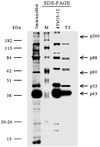Bacteriophage phiYeO3-12, specific for Yersinia enterocolitica serotype O:3, is related to coliphages T3 and T7
- PMID: 10960095
- PMCID: PMC94659
- DOI: 10.1128/JB.182.18.5114-5120.2000
Bacteriophage phiYeO3-12, specific for Yersinia enterocolitica serotype O:3, is related to coliphages T3 and T7
Abstract
Bacteriophage phiYeO3-12 is a lytic phage of Yersinia enterocolitica serotype O:3. The phage receptor is the lipopolysaccharide O chain of this serotype that consists of the rare sugar 6-deoxy-L-altropyranose. A one-step growth curve of phiYeO3-12 revealed eclipse and latent periods of 15 and 25 min, respectively, with a burst size of about 120 PFU per infected cell. In electron microscopy phiYeO3-12 virions showed pentagonal outlines, indicating their icosahedral nature. The phage capsid was shown to be composed of at least 10 structural proteins, of which a protein of 43 kDa was predominant. N-terminal sequences of three structural proteins were determined, two of them showing strong homology to structural proteins of coliphages T3 and T7. The phage genome was found to consist of a double-stranded DNA molecule of 40 kb without cohesive ends. A physical map of the phage DNA was constructed using five restriction enzymes. The phage infection could be effectively neutralized using serum from a rabbit immunized with whole phiYeO3-12 particles. The antiserum also neutralized T3 infection, although not as efficiently as that of phiYeO3-12. phiYeO3-12 was found to share, in addition to the N-terminal sequence homology, several common features with T3, including morphology and nonsubjectibility to F exclusion. The evidence conclusively indicated that phiYeO3-12 is the first close relative of phage T3 to be described.
Figures







References
-
- Ackermann H-W, DuBow M S. Family Podoviridae. In: Ackermann H-W, DuBow M S, editors. Viruses of prokaryotes. II. Natural groups of bacteriophages. Boca Raton, Fla: CRC Press; 1987. pp. 85–100.
-
- Ackermann H-W, DuBow M S, Gershman M, Karska-Wysocki B, Kasatiya S S, Loessner M J, Mamet-Bratley M D, Regué M. Taxonomic changes in tailed phages of enterobacteria. Arch Virol. 1997;142:1381–1390. - PubMed
-
- Al-Hendy A, Toivanen P, Skurnik M. Expression cloning of the Yersinia enterocolitica O:3 rfb gene cluster in Escherichia coli K12. Microb Pathog. 1991;10:47–59. - PubMed
Publication types
MeSH terms
Substances
LinkOut - more resources
Full Text Sources

